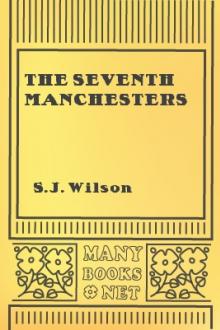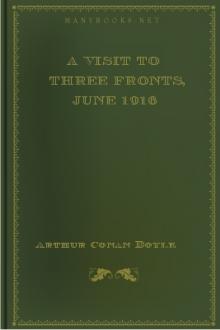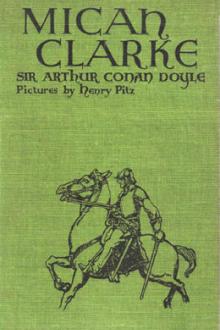The Seventh Manchesters by S. J. Wilson (top ten ebook reader .txt) 📕

- Author: S. J. Wilson
- Performer: -
Book online «The Seventh Manchesters by S. J. Wilson (top ten ebook reader .txt) 📕». Author S. J. Wilson
still remained of the 40th and other divisions, when they found that the
42nd were in position, gradually dribbled through in search of a
long-delayed and well-earned rest. They had been fighting without
respite since the morning of the 21st. The 6th Manchesters were now on
the right of the division in the vicinity of Bihucourt, but they were
uncertain as to the state of affairs on their right. As a matter of
fact, although we were not aware of it at the time, Bapaume had been
taken and a large gap had been left in the line south of our right
flank, through which the Huns were pouring in victorious mass. The New
Zealand division and one brigade of Australians, with the 62nd division
on their left were hurried forward, and after very severe fighting
stopped the enemy rush about Hebuterne, some miles westward of the
position we held on March 25th.
Meanwhile we were in blissful ignorance of our hazardous position and
the Manchesters were preserving strict guard over an exposed right
flank. The 6th came in for a good deal of heavy fighting in the vicinity
of Bihucourt, but they held the village all day. The headquarters of the
7th was in an old shallow dug-out close to the light railway that had
been constructed from Achiet-le-Grand to run eastwards in the direction
of Bullecourt. This railway wound its way through a sort of valley to
the north of which lies Gomiecourt and to the northeast Mory. Due east
on higher ground are Behagnies and Sapignies where the L.F’s. were
making such a fine stand. This high ground continues southwards towards
Bihucourt and Bapaume, and it was along this ridge that most of the
day’s fighting took place.
During the previous night the 7th had been spread out fanwise in
outposts covering the shallow valley, and it was not long after
daylight before the enemy began to drop shells indiscriminately about
this ground. “C” and “D” companies were ordered forward to assist the
5th and “A” and “B” were left in support. Tanks came up and they
courageously crawled out over the ridge and did some very sound work
before being knocked out by guns which had been brought up to unwonted
proximity. It was whilst crawling out to rescue a wounded man of the
crew of a tank that Sergeant Heath, M.M., was mortally wounded. The
127th brigade could not be driven from their positions and they dug
themselves in, in small section posts, confidently awaiting nightfall
and the next day’s fight. The attacks died down and when darkness came,
digging parties went up to assist in the work of consolidation. Events
as described above, however, had decided otherwise, for about 10 p.m. a
divisional staff officer arrived with orders to fall back to a line of
defence between Logeast Wood and Courcelles.
Casualties had been fairly heavy in this day’s work. Capt. J. Baker and
2nd.-Lt. B. Taylor had gone down wounded, while Col. Bromfield, Capt.
Creagh and the M.O. had all been slightly wounded by a shell which
knocked in the entrance to the headquarter’s dug-out. They remained at
duty, although the C.O. suffered considerably from an internal bruise in
the stomach which made it impossible for him to walk without assistance.
The arrangements for clearing the wounded became confused when
Gomiecourt was evacuated, for there the Advanced Dressing Station had
been established. Then it was that the Padre displayed his vigour,
courage and resource. He commandeered a hut close to Achiet and had a
large number of wounded from various battalions collected there.
Eventually he was able to get an ambulance which carried many of them
back to the Casualty Clearing Station, but this process suddenly
stopped. All sorts of conveyances were then seized and men were
gradually carried back. When the order to withdraw became known matters
were critical, but the Padre continued his labours. Difficulties were
not diminished when the Hun commenced to drop 5.9’s near this spot.
Hoskyns was slightly wounded, but he was bound up and carried on his
self-appointed task until some time after the last of the brigade had
gone by, leaving him with no one in front but the Hun. Not until the
last man had been carried safely off did he leave this place, and then
he collected various stragglers and marched them up as a platoon to join
their own units! This, and his continuous plucky and considerate work in
tending bodily as well as spiritual needs during the next few days
obtained for him a well-earned M.C.
The night of the 25th-26th was even more strenuous than the previous
one. About 11.30 p.m. the withdrawal commenced, and was very skilfully
carried out, so skilfully, in fact, that the German battle outposts
could be heard firing intermittently for hours after our troops had
retired. After steady plugging, man-handling everything, we reached a
system of admirably prepared trenches north of Logeast Wood. The pioneer
battalion 7th Northumberland Fusiliers, who had come to the division in
February, had been working upon them all day, and, excellently sited as
they were, they inspired everyone with a great feeling of confidence.
Men took a lively interest in their posts, and after a considerable
amount of organisation sentries were mounted and the battalion settled
down for a rest until the enemy should arrive. It was now 3 a.m. At this
hour it so happened that the division had received another urgent order
to fall back still further. Staff officers made their way on foot
through the congested roads behind the front and searched dimly for the
various brigades, a most uncertain task in view of the rapidity of
events. We were found eventually and the brigade major aroused us from
slumber to transmit the news.
Once again the 7th rose up, shouldered their burdens, and strode
backwards. “What are we going back for? What does it all mean? We held
up Jerry yesterday—why retire?” It all seemed very unsatisfactory and
we were very tired. Food had naturally been scanty and only obtained in
snatches, but much energy was being consumed. It was a disappointed
battalion that straggled wearily through Logeast Wood. We were only just
in time, however, for advance parties of the enemy were already entering
the east side of the Wood as we emerged from the south-west side. Here
we found some explanation of things. Col. Wedgewood, of the 6th,
reported bodies of the enemy moving forward to strike in on our southern
flank, and this news had the effect of an electric shock amongst us.
Col. Bromfield at once ordered positions to be taken up to face the
enemy who were advancing from the south and south-east. “A” and “D”
companies moved out quickly to seize the high ground and one or two
Lewis guns opened fire at the bodies of grey figures in the distance.
Meanwhile, however, the brigadier had decided to cover the
Bucquoy-Ablainzevelle road, and so touch up with the 62nd division, who
had some hours previously occupied a position from Hebuterne to Bucquoy,
and were at that moment resisting violent efforts on the part of the Hun
to turn our right flank. It was, therefore, in the latter village where
we met the gallant Yorkshiremen of the 2nd line West Riding
Territorials. Gen. Henley personally assisted in getting the platoons of
“B” and “C” companies into position, and then “A” and “D” companies were
ordered to withdraw to their line.
When the withdrawal had been completed the 7th were on the right of the
division, with the flank resting on the edge of Bucquoy village. The
road from Bucquoy to Ayette, which was almost south to north, is an
important one and is marked by a row of trees on each side. As one walks
from Bucquoy along this road, another road branching off to the right
from the edge of the village is seen leading down to Ablainzevelle. The
road junction marks the highest portion of ground in the vicinity, and
there is a long sweep eastwards towards Logeast Wood and
Achiet-le-Petit. It was when we noticed the latter place that the whole
irony of the situation broke upon us. Eight month’s ago we had been
enjoying a blissful period of rest on this self-same spot, and such
features as we now gazed upon had merely been used for the purpose of
containing a supposed enemy in the working out of a tactical exercise—a
sham fight. Now—the enemy could not be more real or more alive. He was
here with the sole intent of destroying us by any possible method if we
would not vacate our position. What happened?
The 7th was assured that this was at last the spot where resistance
would be offered. There were no trenches, and the men lay out in the
open on the sloping ground east and south of the Ablainzevelle road,
with intent to dig in as soon as possible. “C” company were on the
right, and they were rather fortunate in being on the site of an old
camp, because in these days of modern war it is necessary to dig a hole
in a tent even, as a safe-guard against bombing. “C” company then
disposed themselves amongst these circular holes, and later found them
useful protection when the heavy shelling commenced. “B” company, in the
centre, were totally exposed, while “A” company on the left, in touch
with the 6th, were almost as bad, although two platoons were able to
make use of the sunk road. “D” company were behind in support and could
occupy portions of an old Boche trench running east and west.
Headquarters lay out in the Ayette road at first until an old Boche
dug-out, not completed, was found farther up the road, and then they got
into it. Platoons had barely been allotted their areas when clumps of
Huns began to appear on the ridge we had just vacated. They proved to be
teams of light machine gunners, and without preliminaries in the matter
of searching for cover, they promptly opened fire, and soon there was a
perfect hail of grazing bullets swishing over the battalion area. German
officers calmly walked about directing operations and the whole scene
resembled a “stunt on the pictures” rather than modern war. They had
made a mistake, though, and if they were seeking dramatic effect it was
only short lived. Our men were delighted at the perfect target they
presented on the skyline, and rat-tat-tatted merrily in reply to the Hun
swish. By this time also “D” company of the Machine Gun battalion had
taken up a position and they also joined in the conversation. The enemy
then considered the advisability of concealment, and he disappeared from
view. Small parties of his infantry meanwhile had dribbled forward,
considerably helped by old systems of trenches which extended down into
the low ground. Our men were ready, however, and met them with a heavy
fusillade whenever they showed themselves.
Between Logeast Wood and Ablainzevelle was a camp of Nisson huts, which
had been protected against bombing, in the usual manner, by thick walls
of earth round each hut. The enemy was now making the fullest possible
use of these, for they afforded him most excellent protection. Luckily
they were on a piece of ground fully exposed to us, and we were able to
get some idea as to his movements in that direction. It was soon evident
that they were to be utilised as a stepping stone to a further advance.
First, light M.G’s. and snipers were brought up, and these dribbled out
of the huts into Ablainzevelle, where they established themselves to the
discomfort of our men, for they were well on our left flank and could
take some of our position in enfilade. The battalion suffered a number
of casualties from this cause. Unfortunately also, our guns had not got
a clear





Comments (0)